Use 'Print preview' to check the number of pages and printer settings.
Print functionality varies between browsers.
Printable page generated Friday, 26 April 2024, 10:44 PM
Hygiene and Environmental Health Module: 22. Solid Waste Management
Study Session 22 Solid Waste Management
Introduction
The common practice for household refuse disposal in rural areas is to dump solid wastes openly in backyard gardens or in an open space. Such indiscriminate disposal is an environmental hazard and can threaten human health and safety. Solid waste that is improperly disposed of can result in a number of problems. It can create a breeding ground for pathogenic microorganisms and vectors of disease, and cause a public nuisance due to unsightliness and bad smell. It can cause contamination of surrounding soil, groundwater and surface water, and it can also create fire hazards, physical hazards and have poisoning effects (from pesticides and insecticides). However, these problems can be avoided by using appropriate management techniques. For all waste management issues, your role should be to engage community members and families in awareness of the solid waste problems in their area and try to change their behaviour. In doing so, it should be possible to have a clean, attractive and sustainable environment.
In this study session, you will learn about the different types of solid waste and their common sources. You will also learn about the stages in solid waste management and appropriate disposal methods. Proper management of solid waste will help your community prevent communicable diseases and safeguard the environment in a sustainable manner.
Learning Outcomes for Study Session 22
When you have studied this session, you should be able to:
22.1 Define and use correctly all of the key words printed in bold. (SAQ 22.1)
22.2 Describe the different sources and characteristics of solid waste. (SAQ 22.2)
22.3 Describe the functional elements of solid waste management. (SAQ 22.3)
22.4 Describe the different methods of solid waste management. (SAQs 22.3 and 22.4)
22.5 Survey solid waste management practices. (SAQ 22.5)
22.1 Sources and classification of solid waste
Solid wastes include household refuse, agricultural remnants, food leftovers, plastic bags, tin cans, ash and packaging, such as cartons and used jonya sacks. They become waste once they have been discarded because they are no longer needed in their present form. Refuse, garbage, litter and street sweepings are all terms used to describe solid wastes in various situations.
In rural parts of Ethiopia, the type of solid waste generated will vary depending on the particular location and the socioeconomic and cultural conditions of the area.
In general, rural households produce wastes that are mostly organic in nature and result from agricultural production and processing activities. They include crop residues, food remnants, leaves and grass from clearing of sites, animal manures and dung, ashes, dead animal carcasses, etc. Other solid wastes could include glass, plastic containers, metal scraps, tin cans, plastic bags, condoms and obsolete agricultural pesticides and insecticides. These solid wastes need to be managed properly in a way that avoids the potential risks to the environment and to human health.
The type of waste will determine the choice of possible disposal methods. Therefore, it is important to be able to classify solid waste according to its characteristics (Table 22.1).
As you may remember from Study Session 18, solid waste can be classified based on its source as residential, agricultural, commercial, industrial, institutional or healthcare waste. You were also introduced to the classification of waste as hazardous or non-hazardous and also as biodegradable or non-biodegradable. Another word used in the context of biodegradable solid waste is putrescible, which means the waste decomposes (rots down) quite quickly. Waste can also be described as combustible or non-combustible depending on whether it will burn or not. Table 22.1 classifies waste using these different properties.
| Main classification | Type | Short description | Examples |
|---|---|---|---|
| Hazardous waste | Solid or semi-solid | Substances that are either ignitable, corrosive, reactive, infectious or explosive | Some obsolete pesticides such as DDT, dieldrin, etc. |
| Non-hazardous waste | Putrescible | Easily decomposable/biodegradable solid waste | Food wastes |
| Non-putrescible | Non-biodegradable solid waste, it includes combustible and non-combustible waste | Plastic bags, bottled water containers, tin cans, etc. |
Putrescible wastes are generated by growing, handling, preparation, cooking and consumption of food. These kinds of wastes tend to be more abundant during the summer (rainy) seasons. Non-putrescible wastes do not decompose easily; they may or may not be combustible. Because they do not break down, they persist in the environment and are often the cause of nuisance and aesthetic problems.
Can you think of any non-putrescible wastes that cause environmental problems in your community?
We don’t know exactly what the waste problems are in your area but a probable answer is plastic bags because they are a widespread problem in Ethiopia.
Plastic bags are commonly known as festal. They are widely used to carry goods from market to home in all areas because they are convenient, cheap and easy to use. Plastic bags are usually non-biodegradable and persist in the environment for a very long time. Moreover, when discarded indiscriminately, they pollute the land surface of your community, prevent rainwater from percolating into the soil, can easily be blown all over the place by wind, and create unsightly and nuisance conditions. The bags can also be easily swallowed by animals, which may block their digestive system and kill them (Figure 22.1). In malaria-prone areas, there is also a potential to create breeding places for mosquitoes because the bags may trap small pools of water.
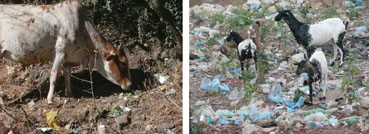
22.1.2 Hazardous waste
Hazardous wastes are treated as a separate category of waste because special management and disposal methods are required. The main sources of hazardous substances are agricultural offices/stores, health offices/stores and possibly also private firms, homes and retail shops. The toxic, corrosive, ignitable, explosive and/or infectious characteristics of these wastes require careful and stringently controlled methods of handling, storing and transportation. Hazardous wastes, because of their particular environmental health hazard, should be identified, quantified and reported to a higher level for further action.
What is an environmental health hazard?
An environmental health hazard is any environmental factor or situation that can cause injury, disease or death.
In Study Session 2 you learned about the causes and types of environmental health hazards. The immediate health effects from hazardous wastes range from bad smells and simple irritation of eyes, skin, throat and breathing (lungs), to serious health conditions that affect the nervous system and could cause paralysis of the functional body parts. Some hazardous solid wastes have teratogenic (birth defects) and carcinogenic (cancer causing) effects.
The long-term effects of hazardous wastes can be devastating to community health and wellbeing. However, it is difficult to quantify the exposure level and predict the health consequences as a result of exposure because the types of hazardous waste are so variable. If you observe or get reports from others about the presence of any hazardous waste, you should report this to the environmental health office and/or the agricultural development agent in your locality.
If you know there are stores of hazardous materials in your community, you should monitor them regularly using observation checklists and by asking for information, and then report your findings if you have any concerns. You should not attempt to bury, burn or dispose of hazardous wastes. Hazardous solid wastes require specialised methods of handling, collection, transportation and disposal. Some wastes, such as obsolete pesticides or radioactive material, may need to be transported out of the country for final disposal. (Hazardous solid wastes from health institutions will be dealt with separately in the next study session.)
22.2 Functional elements of solid waste management
In Study Session 18 you were introduced to the functional elements (stages) of solid waste management which are:
- onsite handling, storage and processing
- collection
- transfer and transport
- resource recovery and processing
- disposal.
The complete set of functional elements will apply in urban centres managed by municipal authorities but not all of them will be relevant in rural areas.
22.2.1 Onsite handling, storage and processing
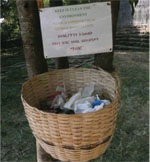
Onsite means these functions are concerned with solid waste at the place where the waste is generated. For residential waste this means at home in the household. Onsite handling is the very first step in waste management. It involves individual family members, households and communities, all of whom need to know how to handle waste properly at this level. ‘Handling’ means the separation of wastes into their different types so they can be dealt with in the most appropriate way, for example, separating putrescible waste for composting. The benefits of appropriate onsite handling include reducing the volume of waste for final disposal and recovering usable materials.
Onsite storage means the temporary collection of waste at the household level. It is important that waste is stored in proper containers. These could be baskets, preferably made from locally available materials, plastic buckets or metal containers (Figure 22.2). Larger containers or dustbins, especially those used for food waste, should be leakproof, have tight lids and be long-lasting. The size of the container should be sufficient to hold at least the amount of solid waste that is generated per day at household level. Institutions and businesses should consider having onsite storage facilities with greater capacity. The proper location of storage containers and the frequency and time of emptying are important factors to be considered for efficient onsite storage.
Some wastes will need some sort of onsite processing before the next steps, for example, in areas where false banana (enset) is used as a staple crop, the byproducts should be chopped into pieces before composting to speed up the rate of decomposition.
22.2.2 Collection, transfer and transport of solid waste
In urban centres, collection is a function that has its own process and services. Waste is collected and held at central transfer stations where waste is stored before it is transported to a final disposal site. In rural areas, waste is not normally collected in this way and disposal is limited to onsite processing options, although sometimes there may be communal collection of solid waste using animal carts.
22.2.3 Resource recovery and processing
Resource recovery means finding a way to use the waste so it becomes a valuable resource, rather than just a disposal problem. This is a very important part of waste management. Resource recovery includes a range of processes for recycling materials or recovering resources from the waste, including composting and energy recovery. Converting the waste into a new product may require energy and equipment; therefore, there needs to be a careful assessment of inputs and outputs in case it is not economically sensible to do it. Resource recovery options are discussed further in the following sections of this study session.
22.2.4 Disposal of solid waste
Even after recycling and resource recovery there will almost certainly be some residual waste that needs final disposal. Methods of disposal can be sanitary or unsanitary. Open field dumping is the most unsanitary method of refuse disposal and is most likely to cause a health hazard. Sanitary methods – including controlled tipping or controlled burial, incineration and sanitary landfill – are discussed later in this study session.
22.3 Integrated solid waste management
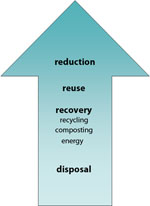
The concept of integrated solid waste management (ISWM) mostly applies to municipal solid waste management in urban centres. The principles can, however, be applied to some extent in rural and peri-urban solid waste management.
In Study Session 18, it was explained that an ISWM approach means considering not only the appropriate disposal of solid waste but integrating this with other management options such as minimising waste production, recycling, composting and other waste recovery options. These different options can be ranked in order of their desirability as management options. This is often represented in a diagram known as the waste management hierarchy (Figure 22.3) that you first met in Study Session 2.
At the top of the hierarchy is reduction, which means keeping the production of waste to a minimum. Next comes reuse, which simply means using something more than once. The third option in the hierarchy is recovery, which includes several separate processes that enable material or energy resources to be recovered from the waste. These include recycling, composting and energy from waste. Finally, the least desirable waste management option is disposal, which includes landfill, tipping and incineration (burning) without energy recovery.
We will now look at the options for waste management in the hierarchy in a little more detail.
22.3.1 Reduction strategies
Reduction strategies are the ways that a household or community may use to try to reduce or minimise the amount of solid waste they produce. This approach is generally more relevant in affluent homes and societies with a wasteful lifestyle. For example, people with more money may not worry about throwing household items away when they can afford to buy replacements. In a business context, using two-sided photocopying of a document reduces the paper used and also therefore the waste produced.
22.3.2 Reuse strategies
Reuse refers to the act of using an item more than once, either for the same or similar purpose. Figure 22.4 shows used plastic bottles and other containers for sale to be reused. Unlike recycling and other recovery options, reuse does not require reprocessing and therefore requires less energy.
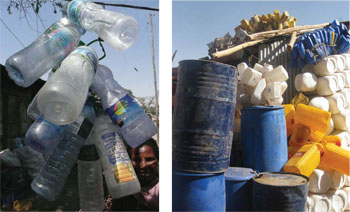
What sort of materials or products are reused for the same or different purposes in your community?
Using plastic bottles or glass containers for water, oil or gasoline are possible answers though there are a number of others from household utensils to personal uses.
22.3.3 Recovery strategies: recycling, composting and energy
Recycling
Recycling is a process by which waste is processed in some way to be reformed into new or similar products. The principle is to make a usable product from the waste. Plastic bottles, newspapers, cardboard and tin cans can all be reprocessed and made into new items. Plastic bags can also be recycled and used to make mats, carpets and other products. Waste metal has a number of possible uses because it is relatively easy to reshape (Figure 22.5). Careful separation of the waste into its different types is important for the efficiency of recycling processes. Recycling not only reduces the quantity of waste but also saves money, so there is an economic, as well as an environmental, incentive to recycle.
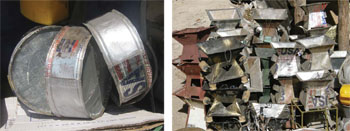
Composting of organic solid wastes
Non-hazardous, putrescible solid wastes such as crop residues, leaves, grass and animal manures can be managed onsite by composting. Composting is a controlled process in which this type of waste is collected in an open pit or heap and is decomposed by natural biological processes. The waste is broken down by the action of a variety of microscopic and other small organisms. The waste is converted into a stabilised material that can be used as fertiliser. Composting is an environmentally friendly way of recovering value from organic waste.
As we discussed in previous sessions, both human waste and organic household waste can be composted. However, the process is different. Human waste can be composted in alternating double pit latrines and in ecological sanitation systems. This process of composting is anaerobic. In the case of organic household waste composting, it is an aerobic process.
What is the difference between aerobic and anaerobic processes?
Aerobic processes require oxygen or air to be present. Anaerobic processes take place without oxygen.
The pit for composting should be dug about 50 m away from a dwelling. The pit needs to be about 1 m deep and at least 1 m breadth and 1 m length. However, the size can vary with the amount of waste generated. The pit depth should be slightly less on one side, about 90 cm, to make a slope so that water does not collect at the bottom. To make the compost, organic matter such as grass, leaves and kitchen/food waste should be thrown into the pit in a shallow layer. It is very important that only biodegradable material is added, so care is needed to sort the waste beforehand. No plastic should be included and bones should be avoided. The waste should then be covered with a thin layer of soil. Covering with soil encourages the composting process and prevents the breeding of flies and other vermin. Air must be allowed to mix with the compost so the contents of the pit need to be turned frequently by digging. The compost needs a small amount of water to keep it moist. The time for the compost to be ready will vary depending on the temperature and the mix of waste among other factors but it should be ready within a few months.
Composting is mostly practised in rural communities. In Ethiopia, it is becoming customary for households to prepare compost from their household organic wastes and you should encourage this practice.
Energy from incineration
To incinerate something is to burn it. In waste management terms, however, incineration means burning in a controlled and managed process – usually at high temperature. Incineration cannot be implemented at household level; it is mostly used for institutional waste management purposes.
Different types of incinerator are used for burning waste. They differ by the temperature at which they operate, the cost of construction, the method of operation and the maintenance requirement. Incinerators can be used for disposal of wastes in health institutions/Health Posts and government and private institutions/offices/industries. Incineration can reduce the volume of refuse by up to 90%; the only remaining residual waste is ash. This significantly reduces the volume of material needing final disposal. Incineration is only classed as ‘recovery’ in waste management if the energy (heat) that is produced is used in some way.
22.3.4 Final disposal: landfill, controlled tipping and burning
Sanitary landfill means the controlled filling of compacted layers of solid waste and soil into pre-prepared land. Large-scale landfill sites for municipal waste need to be designed to protect surface and groundwater from contamination by leachate, the liquid waste that may seep out into the ground underneath the layers of waste. Sanitary landfill sites are not just rubbish dumps for open field dumping. To be classed as sanitary the site must be managed to minimise any negative environmental impact.
Controlled tipping or controlled burial is similar in principle to sanitary landfill but at a smaller scale that is appropriate in rural areas. In controlled tipping/burial, solid waste is disposed of into a dug pit and is regularly covered with soil to avoid attracting disease vectors such as flies and rodents. Covering the waste also stops it from being blown by the wind and avoids bad smells – hence ‘controlled’.
Note that various similar terms may be used to describe different types of waste disposal pit. A refuse pit is a simple pit used to dispose of household refuse, which may or may not be used for controlled tipping (with soil). Some wastes will need to be buried under soil as soon as they are disposed of, in which case the pit may be referred to as a burial pit.
When there is a need for preparing a refuse pit for households, you should advise them that sites for controlled tipping should be 10 m away from the house (preferably at the back of the house), at least 15 m and preferably 30–50 m away from water wells and at a lower ground level. At community level, a communal refuse pit should be 100 m away from houses and they will also need to consider the direction of wind. The site should be easily accessible, with adequate space, and should be fenced so that it is not accessible to children and domestic animals (Figure 22.6).
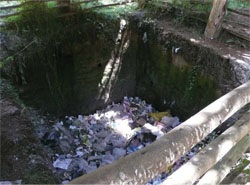
Care must be taken to avoid creating places that could harbour rats or encourage the breeding of flies and other insects. Waste from individual households should be taken to the site in suitable containers such as sacks, plastic bags or buckets. For a community waste disposal pit, it should be a collective responsibility to keep communal areas clean.
Animal carcasses need to be disposed of carefully because they can encourage the breeding of flies and rodents, and attract scavenger animals. They can be disposed of in a common burial pit for the community.
Burning of waste is another possible, though less desirable, method of final disposal. A burning site should be sited downwind and well away from houses. Non-combustible materials such as broken bottles, bones, etc. should be separated and buried at a safe location, not used by farming. Ashes that remain after burning can be used as fertiliser or, if mixed with mud, can be used for plastering of earth walls or floors.
22.4 Surveying solid waste management
The management of solid waste can have a significant impact on human and environmental health. You need to be able to survey the ways that solid waste is managed in your area so that you can assess the situation and identify possible areas for improvement. The list of questions below indicates some of the issues that should be covered in your survey; you may think of other questions to include.
- How many of the households in your kebele have a compost pit?
- Do households without compost pits have adequate space to make one?
- Are there other opportunities for recycling or reuse of waste material?
- Does the community have a communal refuse disposal pit?
- How many people use each refuse pit?
- Is there a need for another communal pit?
- Are the refuse pits fenced and properly managed?
- Is there adequate equipment in your kebele for managing solid waste?
- Is there any open dumping of waste in your kebele?
Answering these questions will provide you with the baseline data you will need for planning improvements to the solid waste disposal facilities. If households do not manage their waste properly you may want to try to find out the reasons for this. It may be lack of resources such as money, space or labour, or there may be behavioural reasons that make people unwilling to use compost pits, for example. Understanding the reasons for the behaviour will help you to give advice to the family and indicate the most effective ways to promote good waste management practices.
After analysing your survey results, you may want to prepare an action plan. There are several possible measures that you could consider including in your plan to lessen the problems. You may want to promote general good practice by ensuring all households have adequate waste containers at home. You may need to ensure all pits are fenced and properly managed. You may need to mobilise the community to dig a new refuse pit, if your survey suggests that one is needed. You may want to focus on a specific problem like plastic bags. You could advise people to collect their plastic bags in one place for recycling and it may also be possible to encourage individuals and enterprises to undertake this profitable activity. You could encourage more reuse of plastic bags by suggesting that people take bags with them to the market or shop to be used again. You could promote other types of bag such as paper bags because they are made of biodegradable materials or permanent bags like cloth bags. You could get the local school involved and initiate a campaign among the children to collect waste bags to clean up the local environment.
Keep in mind that any action plan should be drawn up with the involvement of your community because it will not succeed without their full cooperation. You should include regular monitoring in your plan so you can assess if progress is being made.
Summary of Study Session 22
In Study Session 22, you have learned that:
- In rural communities of Ethiopia, the type of waste produced is mainly agricultural and household waste, which is organic and compostable in nature.
- There are several different ways of classifying waste, including putrescible or non-putrescible, hazardous or non-hazardous, and combustible or non-combustible.
- Hazardous chemicals such as obsolete pesticides are concerns in rural communities.
- The functional elements of solid waste management are onsite storage, processing and handling, collection, transfer and transport, resource recovery, and final disposal.
- Landfill as a means of disposal of solid waste is used in urban situations but may not apply in rural settings. Controlled tipping/burial and composting methods are preferred.
- Disposal of plastic bag wastes (festal) is a cause of concern and needs special attention to be managed sustainably.
- Care should be given in selection of disposal sites at residential or communal level.
- Surveying and community involvement is needed in order to prepare viable action plans to improve solid waste management practices.
Self-Assessment Questions (SAQs) for Study Session 22
Now that you have completed this study session, you can assess how well you have achieved its Learning Outcomes by answering these questions. Write your answers in your Study Diary and discuss them with your Tutor at the next Study Support Meeting. You can check your answers with the Notes on the Self-Assessment Questions at the end of this Module.
SAQ 22.1 (tests Learning Outcome 22.1)
Which of the following statements is false? In each case, say why it is incorrect.
A Recycling is the best approach to solid waste management.
B Composting is an aerobic decomposition process for converting organic solid waste into useful compost.
C Reusing plastic water bottles is an example of waste recovery.
D Controlled tipping is so called because only a limited quantity of waste can be tipped at any one time.
Answer
A is false. Recycling is a good method of waste management but reducing the amount of waste produced in the first place or reusing the waste without reprocessing is preferred.
B is true. Composting of solid waste is an aerobic decomposition process that produces compost.
C is false. Waste recovery means that something useful is recovered from the waste; reuse of waste simply means using the item again in the same way it was used in the first place.
D is false. Controlled tipping is called ‘controlled’ because the waste is regularly covered with soil rather than just left in the open.
SAQ 22.2 (tests Learning Outcome 22.2)
Categorise the different kinds of waste listed below as hazardous or non-hazardous, and as compostable or non-compostable.
Tin cans, manure, grass, obsolete herbicides, paper bags, plastic festal, expired drugs, potato peelings.
Answer
| Hazardous | Non-hazardous | |
|---|---|---|
| Compostable | Manure, grass, paper bags, potato peelings | |
| Non-compostable | Obsolete herbicides, expired drugs | Tin cans, plastic festal |
SAQ 22.3 (tests Learning Outcomes 22.3 and 22.4)
List the functional elements of solid waste management. Which of these are relevant to rural settings? Explain why these are relevant but the others are not.
Answer
The functional elements of waste management are: onsite handling, storage and processing; collection; transfer and transport; resource recovery and processing; and disposal. In rural areas, waste is not normally collected or transported, so the second and third elements are not relevant. Most waste in rural areas is organic and there is plenty of space. Onsite handling, resource recovery in the form of recycling or composting and final disposal are found in rural areas.
SAQ 22.4 (tests Learning Outcome 22.4)
Briefly describe the preparation of compost.
Answer
Compost can be made from household kitchen food waste, leaves, grass, kitchen waste, and any other organic biodegradable material. The compostable waste must be separated out so it contains no plastic or metal. The waste is put in a pit or heap at least 1 m x 1 m x 1 m. It needs a little water and it should be turned over regularly to provide air for the composting organisms. The resulting compost should be like soil and have a good earthy smell.
SAQ 22.5 (tests Learning Outcome 22.5)
Identify two important indicators used to monitor solid waste management in a community. Describe how you would assess them.
Answer
There are several possible indicators that can be used to assess waste management practices. These include the number of households with a compost pit, whether there is a communal refuse pit, the number of people using a communal pit, if there is one, whether the refuse pits are fenced and managed, and others. You would assess these indicators by visiting the community, observing people’s practice and discussing with them what they did with their solid waste.